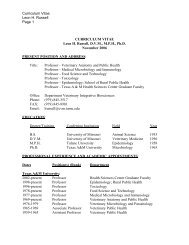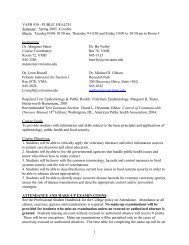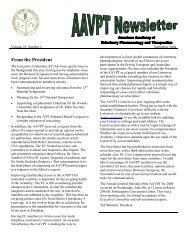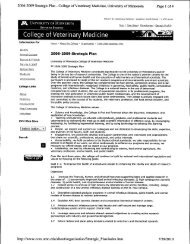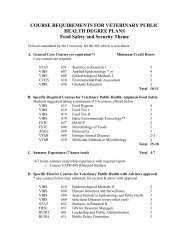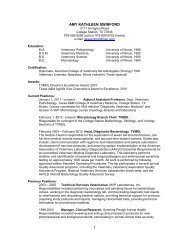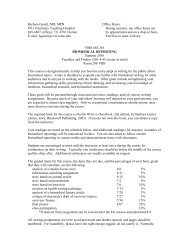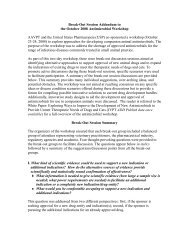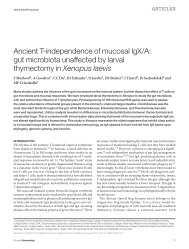View PDF - College of Veterinary Medicine - Texas A&M University
View PDF - College of Veterinary Medicine - Texas A&M University
View PDF - College of Veterinary Medicine - Texas A&M University
Create successful ePaper yourself
Turn your PDF publications into a flip-book with our unique Google optimized e-Paper software.
References<br />
[1] M.J. Berridge, Calcium signalling remodelling and disease, Biochemical Society<br />
Transactions 40 (2012) 297–309.<br />
[2] J. Sobol<strong>of</strong>f, B.S. Rothberg, M. Madesh, D.L. Gill, STIM proteins: dynamic calcium<br />
signal transducers, Nature Reviews Molecular Cell Biology 13 (2012)<br />
549–565.<br />
[3] H. Kawasaki, S. Nakayama, R.H. Kretsinger, Classification and evolution <strong>of</strong> EFhand<br />
proteins, Biometals 11 (1998) 277–295.<br />
[4] K.L. Yap, J.B. Ames, M.B. Swindells, M. Ikura, Diversity <strong>of</strong> conformational states<br />
and changes within the EF-hand protein superfamily, Proteins 37 (1999)<br />
499–507.<br />
[5] F. Friedberg, A.R. Rhoads, Evolutionary aspects <strong>of</strong> calmodulin, IUBMB Life 51<br />
(2001) 215–221.<br />
[6] T.E. Gillis, C.R. Marshall, G.F. Tibbits, Functional and evolutionary relationships<br />
<strong>of</strong> troponin C, Physiological Genomics 32 (2007) 16–27.<br />
[7] R.D. Burgoyne, Neuronal calcium sensor proteins: generating diversity in neuronal<br />
Ca 2+ signalling, Nature Reviews Neuroscience 8 (2007) 182–193.<br />
[8] R.D. Burgoyne, J.L. Weiss, The neuronal calcium sensor family <strong>of</strong> Ca 2+ -binding<br />
proteins, Biochemical Journal 353 (2001) 1–12.<br />
[9] K.-H. Braunewell, The darker side <strong>of</strong> Ca 2+ signaling by neuronal Ca 2+ -sensor proteins:<br />
from Alzheimer’s disease to cancer, Trends in Pharmacological Sciences<br />
26 (2005) 345–351.<br />
[10] K.-H. Braunewell, A. Szanto, Visinin-like proteins (VSNLs): interaction partners<br />
and emerging functions in signal transduction <strong>of</strong> a subfamily <strong>of</strong> neuronal Ca 2+ -<br />
sensor proteins, Cell and Tissue Research 335 (2009) 301–316.<br />
[11] H. McCue, L. Haynes, R. Burgoyne, Bioinformatic analysis <strong>of</strong> CaBP/calneuron<br />
proteins reveals a family <strong>of</strong> highly conserved vertebrate Ca 2+ -binding proteins,<br />
BMC Research Notes 3 (2010) 118.<br />
[12] H.V. McCue, L.P. Haynes, R.D. Burgoyne, The diversity <strong>of</strong> calcium sensor proteins<br />
in the regulation <strong>of</strong> neuronal function, Cold Spring Harbor Perspectives<br />
in Biology 2 (2010) a004085.<br />
[13] T. Ravasi, K. Hsu, J. Goyette, K. Schroder, Z. Yang, F. Rahimi, L.P. Miranda, P.F. Alewood,<br />
D.A. Hume, C. Geczy, Probing the S100 protein family through genomic<br />
and functional analysis, Genomics 84 (2004) 10–22.<br />
[14] B.W. Moore, A soluble protein characteristic <strong>of</strong> the nervous system, Biochemical<br />
and Biophysical Research Communications 19 (1965) 739–744.<br />
[15] M. Ikura, J.B. Ames, Genetic polymorphism and protein conformational plasticity<br />
in the calmodulin superfamily: two ways to promote multifunctionality,<br />
Proceedings <strong>of</strong> the National Academy <strong>of</strong> Sciences <strong>of</strong> the United States <strong>of</strong> America<br />
103 (2006) 1159–1164.<br />
[16] K. Magdalini, H. Marcel, H. Daniel, The human epidermal differentiation complex:<br />
cornified envelope precursors, S100 proteins and the ‘fused genes’ family,<br />
Experimental Dermatology 21 (2012) 643–649.<br />
[17] J. Henry, E. Toulza, C.Y. Hsu, L. Pellerin, S. Balica, J. Mazereeuw-Hautier, C. Paul,<br />
G. Serre, N. Jonca, M. Simon, Update on the epidermal differentiation complex,<br />
Frontiers in Bioscience 17 (2012) 1517–1532.<br />
[18] S.J. Brown, W.H.I. McLean, One remarkable molecule: filaggrin, Journal <strong>of</strong> Investigative<br />
Dermatology 132 (2012) 751–762.<br />
[19] P. Krieg, M. Schuppler, R. Koesters, A. Mincheva, P. Lichter, F. Marks, Repetin<br />
(Rptn), a new member <strong>of</strong> the “fused gene” subgroup within the S100 gene family<br />
encoding a murine epidermal differentiation protein, Genomics 43 (1997)<br />
339–348.<br />
[20] R. Contzler, B. Favre, M. Huber, D. Hohl, Cornulin, a new member <strong>of</strong> the “fused<br />
gene” family, is expressed during epidermal differentiation, Journal <strong>of</strong> Investigative<br />
Dermatology 124 (2005) 990–997.<br />
[21] R.O. Morgan, S. Martin-Almedina, M. Garcia, J. Jhoncon-Kooyip, M.-P. Fernandez,<br />
Deciphering function and mechanism <strong>of</strong> calcium-binding proteins from<br />
their evolutionary imprints, Biochimica et Biophysica Acta – Molecular Cell<br />
Research 1763 (2006) 1238–1249.<br />
[22] V.G. Fonseca, J. Rosa, V. Laize, P.J. Gavaia, M.L. Cancela, Identification <strong>of</strong> a new<br />
cartilage-specific S100-like protein up-regulated during endo/perichondral<br />
mineralization in gilthead seabream, Gene Expression Patterns 11 (2011)<br />
448–455.<br />
[23] A.M. Kraemer, L.R. Saraiva, S.I. Korsching, Structural and functional diversification<br />
in the teleost S100 family <strong>of</strong> calcium-binding proteins, BMC Evolutionary<br />
Biology 8 (2008) 48.<br />
[24] C.D. Hsiao, M. Ekker, H.J. Tsai, Skin-specific expression <strong>of</strong> ictacalcin, a homolog<br />
<strong>of</strong> the S100 genes, during zebrafish embryogenesis, Developmental Dynamics<br />
228 (2003) 745–750.<br />
[25] J. Bobe, F.W. Goetz, A S100 homologue mRNA isolated by differential display<br />
PCR is down-regulated in the brook trout (Salvelinus fontinalis) post-ovulatory<br />
ovary, Gene 257 (2000) 187–194.<br />
[26] Z.E. Parra, Y. Ohta, M.F. Criscitiello, M.F. Flajnik, R.D. Miller, The dynamic<br />
TCRdelta: TCRdelta chains in the amphibian Xenopus tropicalis utilize antibodylike<br />
V genes, European Journal <strong>of</strong> Immunology 40 (2010) 2319–2329.<br />
D.B. Zimmer et al. / Cell Calcium 53 (2013) 170– 179 179<br />
[27] T.A. Hall, BioEdit: a user-friendly biological sequence alignment editor and<br />
analysis program for Windows 95/98/NT, Nucleic Acids Symposium Series 41<br />
(1999) 95–98.<br />
[28] K. Tamura, J. Dudley, M. Nei, S. Kumar, MEGA4: Molecular Evolutionary Genetics<br />
Analysis (MEGA) s<strong>of</strong>tware version 4.0, Molecular Biology and Evolution 24<br />
(2007) 1596–1599.<br />
[29] K. Tamura, D. Peterson, N. Peterson, G. Stecher, M. Nei, S. Kumar, MEGA5: molecular<br />
evolutionary genetics analysis using maximum likelihood, evolutionary<br />
distance, and maximum parsimony methods, Molecular Biology and Evolution<br />
28 (2011) 2731–2739.<br />
[30] R. Schwarz, M. Dayh<strong>of</strong>f, Matrices for detecting distant relationships, in: M.<br />
Dayh<strong>of</strong>f (Ed.), Atlas <strong>of</strong> Protein Sequences, National Biomedical Research Foundation,<br />
1979, pp. 353–358.<br />
[31] M.F. Criscitiello, Y. Ohta, M. Saltis, E.C. McKinney, M.F. Flajnik, Evolutionarily<br />
conserved TCR binding sites, identification <strong>of</strong> T cells in primary lymphoid<br />
tissues, and surprising trans-rearrangements in nurse shark, Journal <strong>of</strong><br />
Immunology 184 (2010) 6950–6960.<br />
[32] J. Felsenstein, Confidence limits on phylogenies: an approach using the bootstrap,<br />
Evolution 39 (1985) 783–791.<br />
[33] R.D. Page, Visualizing phylogenetic trees using Tree<strong>View</strong>, in: A.D. Baxevanis,<br />
et al. (Eds.), Current Protocols in Bioinformatics/Editoral Board, John Wiley &<br />
Sons, Hoboken, NJ, 2002 (Chapter 6, Unit 6.2).<br />
[34] R.O. Morgan, S. Martin-Almedina, M. Garcia, J. Jhoncon-Kooyip, M.P. Fernandez,<br />
Deciphering function and mechanism <strong>of</strong> calcium-binding proteins from their<br />
evolutionary imprints, Biochimica et Biophysica Acta 1763 (2006) 1238–1249.<br />
[35] X. Shang, H. Cheng, R. Zhou, Chromosomal mapping, differential origin and evolution<br />
<strong>of</strong> the S100 gene family, Genetics Selection Evolution 40 (2008) 449–464.<br />
[36] F. Abascal, R. Zardoya, M.J. Telford, TranslatorX: multiple alignment <strong>of</strong><br />
nucleotide sequences guided by amino acid translations, Nucleic Acids<br />
Research 38 (2010) W7–W13.<br />
[37] J.K. Kulski, C.P. Lim, D.S. Dunn, M. Bellgard, Genomic and phylogenetic analysis<br />
<strong>of</strong> the S100A7 (Psoriasin) gene duplications within the region <strong>of</strong> the S100 gene<br />
cluster on human chromosome 1q21, Journal <strong>of</strong> Molecular Evolution 56 (2003)<br />
397–406.<br />
[38] Y. Zhou, W. Yang, M. Kirberger, H.W. Lee, G. Ayalasomayajula, J.J. Yang, Prediction<br />
<strong>of</strong> EF-hand calcium-binding proteins and analysis <strong>of</strong> bacterial EF-hand<br />
proteins, Proteins 65 (2006) 643–655.<br />
[39] W. Lesniak, Epigenetic regulation <strong>of</strong> S100 protein expression, Clinical Epigenetics<br />
2 (2011) 77–83.<br />
[40] W.J. Murphy, E. Eizirik, S.J. O’Brien, O. Madsen, M. Scally, C.J. Douady, E. Teeling,<br />
O.A. Ryder, M.J. Stanhope, W.W. de Jong, M.S. Springer, Resolution <strong>of</strong> the early<br />
placental mammal radiation using Bayesian phylogenetics, Science 294 (2001)<br />
2348–2351.<br />
[41] C. de Guzman Strong, S. Conlan, C.B. Deming, J. Cheng, K.E. Sears, J.A. Segre, A<br />
milieu <strong>of</strong> regulatory elements in the epidermal differentiation complex syntenic<br />
block: implications for atopic dermatitis and psoriasis, Human Molecular<br />
Genetics 19 (2010) 1453–1460.<br />
[42] D.B. Zimmer, J. Chessher, W. Song, Nucleotide homologies in genes encoding<br />
members <strong>of</strong> the S100 protein family, Biochimica et Biophysica Acta 1313 (1996)<br />
229–238.<br />
[43] R. Donato, B.R. Cannon, G. Sorci, F. Riuzzi, K. Hsu, D.J. Weber, C.L. Geczy, Functions<br />
<strong>of</strong> S100 proteins, Current Molecular <strong>Medicine</strong> (2012) [Epub ahead <strong>of</strong><br />
print].<br />
[44] D.B. Zimmer, D.J. Weber, The calcium-dependent interaction <strong>of</strong> S100B with its<br />
protein targets, Cardiovascular Psychiatry and Neurology (2010) [2010 Epub].<br />
[45] A. Landar, R.R. Rustandi, D.J. Weber, D.B. Zimmer, S100A1 utilizes different<br />
mechanisms for interacting with calcium-dependent and calciumindependent<br />
target proteins, Biochemistry 37 (1998) 17429–17438.<br />
[46] K.M. Vallely, R.R. Rustandi, K.C. Ellis, O. Varlamova, A.R. Bresnick, D.J. Weber,<br />
Solution structure <strong>of</strong> human Mts1 (S100A4) as determined by NMR spectroscopy,<br />
Biochemistry 41 (2002) 12670–12680.<br />
[47] R.P. House, S.C. Garrett, A.R. Bresnick, Moving aggressively: S100A4 and tumor<br />
invasion, in: A. Fatatis (Ed.), Signaling Pathways and Molecular Mediators in<br />
Mestastasis, Springer, New York, NY, 2012, pp. 91–114.<br />
[48] M. Du, G. Wang, T.M. Ismail, S. Gross, D.G. Fernig, R. Barraclough, P.S. Rudland,<br />
S100p dissociates myosin IIA filaments and focal adhesion sites to reduce<br />
cell adhesion and enhance cell migration, Journal <strong>of</strong> Biological Chemistry 287<br />
(2012) 15330–15344.<br />
[49] D.B. Zimmer, J. Chaplin, A. Baldwin, M. Rast, S100-mediated signal transduction<br />
in the nervous system and neurological diseases, Cellular and Molecular Biology<br />
(Noisy-le-grand) 51 (2005) 201–214.<br />
[50] S.B. Zanello, R.L. Boland, A.W. Norman, cDNA sequence identity <strong>of</strong> a vitamin<br />
D-dependent calcium-binding protein in the chick to calbindin D-9K,<br />
Endocrinology 136 (1995) 2784–2787.<br />
[51] S. Ohno, Evolution by Gene Duplication, Springer-Verlag, Berlin, New York,<br />
1970.




